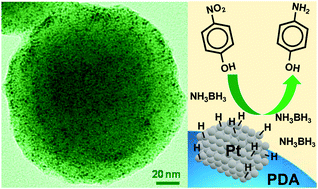Ligand-free sub-5 nm platinum nanocatalysts on polydopamine supports: size-controlled synthesis and size-dictated reaction pathway selection†
Abstract
Noble metal nanoparticles exhibit intriguing size-dependent catalytic activities toward a plethora of important chemical reactions. A particularly interesting but rarely explored scenario is that some catalytic molecule-transforming processes may even inter-switch among multiple reaction pathways when the dimensions of a metal nanocatalyst are deliberately tuned within specific size windows. Here, we take full advantage of the adhesive surface properties of polydopamine to kinetically maneuver the surface-mediated nucleation and growth of Pt nanocrystals, which enables us to synthesize polydopamine-supported sub-5 nm Pt nanocatalysts with precisely tunable particle sizes, narrow size distributions, ligand-free clean surfaces, and uniform dispersion over the supports. The success in precisely tuning the particle size of ligand-free Pt nanocatalysts within the sub-5 nm size window provides unique opportunities for us to gain detailed, quantitative insights concerning the intrinsic particle size effects on the pathway selection of catalytic molecular transformations. As exemplified by Pt-catalyzed nitrophenol reduction by ammonia borane, catalytic transfer hydrogenation reactions may inter-switch between two fundamentally distinct bimolecular reaction pathways, specifically the Langmuir–Hinshelwood and the Eley–Rideal mechanisms, as the size of the Pt nanocatalysts varies in the sub-5 nm regime.



 Please wait while we load your content...
Please wait while we load your content...